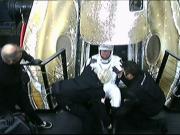Physicist Stephen Hawking and Russian billionaire Yuri Milner have come together yet again in a futuristic plan to send several nanocraft to explore nearby star systems for human habitation.
The tiny spacecraft as small as a mobile phone and travelling at a fifth of the speed of light could reach nearby stars like Alpha Centauri in as short as 30 years, quickening the search for other liveable planets.
"I believe what makes us unique is transcending our limits," Professor Hawking said at the Breakthrough Initiatives announcement. "Earth is a wonderful place, but it might not last forever. Sooner or later, we must look to the stars — Breakthrough Starshot is a very exciting first step on that journey."
With a lightsail propelled by light beamed up by an array of lasers on the ground, the nanocraft will travel more than 1,000 times faster than today's spacecraft. Aided by advances in microelectronics, a gram-scale wafer on board will carry cameras, photon thrusters, power supply, navigation and communication equipment needed.
Milner is backing the project called Breakthrough Starshot which could cost as much as $13 billion but could take many years to realize. Facebook founder Mark Zuckerberg is also a project member.
"The human story is one of great leaps," said Yuri Milner, founder of the Breakthrough Initiatives. "55 years ago today, Yuri Gagarin became the first human in space. Today, we are preparing for the next great leap - to the stars."
Pete Worden, the former director of NASA's Ames Research Centre, who leads the project said, "The thing would look like the chip from your cell phone with this very thin gauzy light sail … [that] would be something like [3.5 metres] across." The plan is to send a larger, conventional spacecraft containing thousands of nanocraft into orbit from where the nanocraft would then be launched one by one. A Cornell project two years ago called KickSat failed after the craft carrying 104 micro-satellites failed to release them in space, writes ABC News.
Last year Milner announced Breakthrough Listen, a $135-million project to monitor radio signals for signs of intelligent life across the universe, a project that saw experts voicing concern. Even Swinburne University of Technology's Professor Matthew Bailes who is to lead the search hinted that it could be potentially dangerous to respond to alien signals. The project involves two high-power telescopes pointed at some spots in the universe believed to be possible hotspots for alien activity.
Hawking has for sometime now been harking on the need to look for other planets in the eventuality of Earth turning inhabitable, a la Interstellar for those who have seen the sci-fi blockbuster. Nuclear war, global warming, dangerous viruses and artificial intelligence have been cited as possible harbingers of humanity's doom on Earth. The physicist has forecast that a global disaster is inevitable in a few thousand years and called on the need to look for alternate homes out in the universe for mankind to survive.








